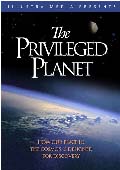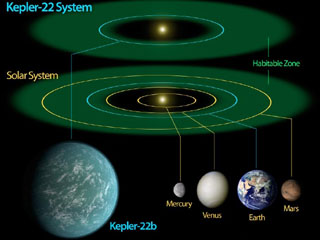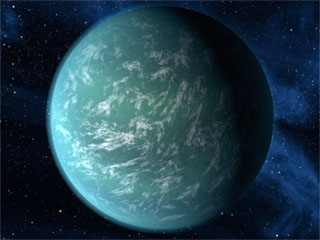Kepler 22b: Why it is Almost Certainly NOT Habitable

Introduction
NASA has made an announcement of finding the first "earth-like" planet in the middle of the star's habitable zone through the Kepler satellite, which finds planets through stellar dimming during transits. To date (2011), over 700 extrasolar planets have been confirmed to exist, although Kepler has a potential list of over 2,000 more. The current announcement probably had the widest news coverage of any recent NASA statement. This page examines the claims, along with distortions by the media, and NASA artists themselves.
Parent star
Stars and planets are given names according to the following convention. A star's name usually includes some numbers identifying it. The planets being discovered by the Kepler mission are being numbered sequentially by discovery. Stars are labeled with the number followed by the letter "a." So, the "name" of the star around which the new earth-like planet is revolving is designated as Kepler 22a.1 Planets are numbered with subsequent letters, beginning with "b." So, the newly discovered planet is designated as Kepler 22b. Unlike the last announcement of the last "earth-like planet," Gliese 581g, within its small star's habitable zone, this one is orbiting a near solar-twin. Small stars, like Gliese 581a, exhibit lower energy spectral emissions, which are not conducive as strong supporters of photosynthesis. In addition, their weak emissions require planets to be located very close to the parent star to be within the habitable zone, resulting in tidal locking (one side of the planet always faces the star). Stars larger than the Sun burn much more quickly, with rapid escalation of stellar luminosity, which continually moves the habitable zone further and further away from the star. So, realistically, only stars that are nearly solar twins would be conducive to harboring life. Kepler 22a happens to be such a star, which is why scientists were so excited to find a rocky planet orbiting around it.
Habitable zone
NASA's definition of the habitable zone is very generous. For example, using our own solar system, they say that Venus and Mars are both within the habitable zone. However, according to the inverse square law, the solar irradiance received by Venus should be nearly twice that of earth. Even with Earth's relatively thin atmosphere, it would be uninhabitable, due to overheating, if located as close as the orbit of Venus. However, since Venus has a thick greenhouse atmosphere, surface temperatures are in excess of 460°C—even higher than Mercury, the closest planet to the Sun. If the earth were located toward the outer limits of the Sun's habitable zone, beyond the orbit of Mars, it would a frozen ball of ice. Planet Kepler 22b is located near the inner part of Kepler 22a's habitable zone, so it's likely to be much warmer than the claimed 72°F in news stories.2
Planet Kepler 22b
Although declared to be "earth-like," Kepler 22b is actually 2.4 times more massive than earth. This increased mass likely impacts the atmospheric content of the planet. Planets must possess a minimal mass in order to retain an atmosphere. For example, Mars has only 10% the mass of the earth, and almost no atmosphere. Extensive evidence indicates that it once had a thicker atmosphere and large bodies of water on its surface. However, because of its reduced gravity, it lost nearly all of that atmosphere and water due to the actions of the solar wind. The earth originally had a much denser atmosphere that was mostly blasted into space during the collision that formed the Moon. Had it not been for this fortuitous collision, the earth would have had an atmosphere similar to Venus (81% the mass of the earth), which has an atmosphere 80 times denser than earth's. NASA scientists have assumed that Kepler 22b has an atmosphere similar to earth's. This assumption is almost certainly wrong, unless the planet experienced a large collision event, similar to earth's, early in its history. With at least 2.5 times the mass of earth, the planet would likely have an atmosphere much denser than Venus, making life there extremely unlikely. Such a dense atmosphere would contribute to a large greenhouse effect, which would raise temperatures dramatically. If Kepler 22b ever had water, it probably doesn't now, having been evaporated and blown away by Kepler 22a's solar wind. The artist's impression (right) is almost certainly wrong, since even NASA scientists admitted in their December 20, 2011 news conference that Kepler 22b most likely has a very dense atmosphere compared to earth (not the thin, wispy clouds we see in the diagram).
Conclusion 
 The newly
confirmed planet Keppler 22b has been advertised as being an earth-sized planet
within the habitable zone of its star, with an average temperature of 72F. What
the new media does not tell you is that the temperature assumptions are based
upon the planet having an atmosphere identical to earth's. The assumption is
extremely unlikely. First, the earth's atmosphere is very thin for the size of
planet, having achieved such a thin atmosphere due to the collision that formed
earth's moon. Since Kelper 22b is 2.4 times more massive than earth, it most
likely has an atmosphere as dense or denser than Venus. With such a thick
atmosphere, any water on the planet would be in the form of superheated steam or
boiled off completely. I wouldn't plan on moving there any time soon. If you do,
remember to take lots of sunblock!
The newly
confirmed planet Keppler 22b has been advertised as being an earth-sized planet
within the habitable zone of its star, with an average temperature of 72F. What
the new media does not tell you is that the temperature assumptions are based
upon the planet having an atmosphere identical to earth's. The assumption is
extremely unlikely. First, the earth's atmosphere is very thin for the size of
planet, having achieved such a thin atmosphere due to the collision that formed
earth's moon. Since Kelper 22b is 2.4 times more massive than earth, it most
likely has an atmosphere as dense or denser than Venus. With such a thick
atmosphere, any water on the planet would be in the form of superheated steam or
boiled off completely. I wouldn't plan on moving there any time soon. If you do,
remember to take lots of sunblock!
Related Resources 
- Does 'Goldilocks' Planet Gliese 581g Harbor Life?
- The Incredible Design of the Earth and Our Solar System
- Moons Like Earth's Moon are Rare in the Universe
- God of the Gaps - Do All Christian Apologetics Fall Into This Kind of Argument?
 Rare
Earth: Why Complex Life is Uncommon in the Universe by Peter D. Ward and
Donald Brownlee
Rare
Earth: Why Complex Life is Uncommon in the Universe by Peter D. Ward and
Donald Brownlee
A secular book that recognizes the improbable design of the earth. Paleontologist Peter D. Ward and astrobiologist Donald Brownlee examine the unusual characteristics of our galaxy, solar system, star, and Earth and conclude that ET may have no home to go to. Surprisingly, the authors conclude that the amazing "coincidences" are the result of good luck and chance.
 The
Creator and the Cosmos
The
Creator and the Cosmos![]() by Dr.
Hugh Ross
by Dr.
Hugh Ross
A classic book for modern Christian apologetics and science, recently updated with fully one third of the book updated. Dr. Ross presents the latest scientific evidence for intelligent design of our world and an easy to understand introduction to modern cosmology. This is a great book to give agnostics, who have an interest in cosmology and astronomy.
References 
- NASA's Kepler Mission Confirms Its First Planet in Habitable Zone of Sun-like Star. Kepler Mission News, December 5, 2011.
- On newly discovered Earth-like planet, it's 72 degrees. Florida Today, December 6, 2011.
- Leslie Mullen. 2010. Doubt cast on existence of possibly habitable alien planet, Astrobiology Magazine.
Today's New Reason to Believe
Integrating Science and Faith
- 11/05/2012 12:52 AM
Imperial College Debate on Evidence for God
In spring of 2012, my colleague Kenneth Samples and I spent several days in London, England, speaking in universities, churches, leadership gatherings, and at a conference. God gave us a wonderful opportunity to take RTB’s message of science-faith compatibility overseas. Here I recap my interactions with distinguished professor Lewis Wolpert. **** On May 24, 2012, … Read more
() - 11/01/2012 12:30 AM
Resource Highlight: Creation Day Debates
Earlier this week, guest writer Otis Graf explained how the ejection dynamics of meteoroids from the star Beta Pictoris and the meteoroids’ detection on Earth cannot be reconciled with a young universe—thus challenging young-earth proponent Dr. Jason Lisle’s model for solving the distant starlight problem. RTB’s Hugh Ross and Fazale Rana have debated Dr. Lisle … Read more
() - 10/29/2012 12:44 AM
Alien Particles Challenge a Young-Earth Creation Model
A collimated beam of meteoroids from the star Beta Pictoris has been discovered. However, the ejection dynamics at the star and the meteoroids’ detection on Earth cannot be reconciled with a young universe. This discovery directly challenges two tenets of young-earth proponent Dr. Jason Lisle’s model for solving the distant starlight problem. **** The 1950s … Read more
() - 10/25/2012 12:05 PM
TNRTB Classic: Basking in UV Radiation
On Monday, guest writer and visiting scholar Hugh Henry discussed research into the effects of radiation on the human body. Despite our fear of radiation, it seems that God has designed the human physiology to withstand a reasonable about of exposure. Check out this previous TNRTB from Fazale Rana on how our DNA reacts to … Read more
() - 10/25/2012 12:34 AM
TNRTB Classic: Basking in UV Radiation
On Monday, guest writer and visiting scholar Hugh Henry discussed research into the effects of radiation on the human body. Despite our fear of radiation, it seems that God has designed the human physiology to withstand a reasonable about of exposure. Check out this previous TNRTB from Fazale Rana on how our DNA reacts to … Read more
() - 10/22/2012 12:50 PM
“Deadly” Radiation and God’s Design
A feature article in the August 2012 issue of Scientific American trumpets a scary warning: “Deadly Rays from Clouds—Thunderstorms Give Out Powerful Blasts of X-Rays and Gamma Rays.”1 Headlines are written to grab the reader’s attention—whether or not the article’s content lives up to the hype. At the end of this particular article, the authors … Read more
() - 10/18/2012 12:26 AM
TNRTB Classic: Increased Oxygen
Earth experienced many events that brought it to the brink of becoming a barren wasteland. Two dramatic increases in the atmospheric oxygen content (2.5 and 0.8 billion years ago, respectively) resulted in mile-thick ice sheets that nearly encased the planet. Yet Earth rebounded from all these events, better prepared for the new life that arrived … Read more
() - 10/15/2012 12:17 AM
First Plants Bring Major Climate Change
RTB’s creation model posits that the change in life throughout Earth’s history reflects the work of a divine intelligence transforming a hostile-to-life planet into one capable of supporting humanity. As the environs change, so must the life. Studies of the first plant life on the continents show how the plants altered the land and atmosphere … Read more
() - 10/11/2012 12:36 AM
TNRTB Classic: Junk DNA and the Nucleoskeletal Hypothesis
A few days ago I wrote about the ENCODE project and the new recognition that, at minimum, 80 percent of the human genome consists of functional DNA elements. Despite some skeptics’ complaints that the media, creationists, and intelligent design adherents have misconstrued the ENCODE report, the project’s results stand. The human genome is not a vast … Read more
() - 10/08/2012 12:26 AM
Responding to ENCODE “Skeptics”
Recently, the ENCODE Project Consortium reported that 80 percent of the human genome consists of functional elements, major indicators of design. But some skeptics assert (loudly) that the results of the ENCODE project have been overhyped and misconstrued. In this article, I respond to the most salient points made by the ENCODE “skeptics.” The human … Read more
()
http://www.godandscience.org/apologetics/planet_kepler_22b_habitable_zone.html
Last updated December 21, 2011





